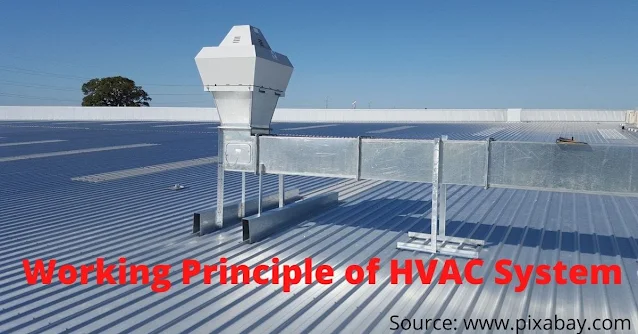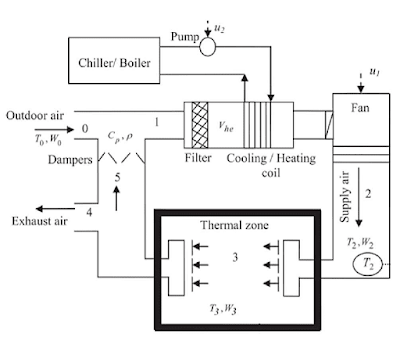Understanding the Working Principle and Components of HVAC Systems
The pharmaceutical industry is highly dependent on precise temperature and relative humidity control to produce high-quality and safe products, HVAC system is a technology that provides the answer to the needs of the pharmaceutical industry. The term HVAC refers to Heating, Ventilation, and Air Conditioning, and it is responsible for controlling the environmental conditions in the pharmaceutical formulation plant. The HVAC system is the latest technology for the pharma industry to maintain consistent and controlled temperatures and relative humidity levels in different areas. The temperature and humidity are very essential conditions for drug manufacturing for ensuring those medications are safe and effective for patients.
 |
| source-pixabay.com |
Also Read: Principle of autoclave
Principle of the HVAC system?
The basic operation of an HVAC system is circulating air back into the premises after it has been heated or cooled as needed through a network of ducts. HVAC systems maintain the quality of air by regulating indoor settings' temperature, and humidity.
The heating, ventilation, and air conditioning (HVAC) system works on three different sub-principles are Thermodynamics, fluid flow, and heat transfer. All three sub-principles are utilized at different steps of the whole process in the HVAC system. The Thermodynamics concept comes into effect to maintain the indoor air quality of the premises. The fluid flow mechanism comes into effect to maintain the temperature by passing the coolants in the coils of the air conditioning system. The third portion of the principle is the heat transfer segment of the main principle, where desired heat supply to the air is supplied in the room.
Heating in an HVAC system:
The heating system is an essential component of any HVAC system. It provides warmth to the spaces by raising the temperature of the air, the air circulates throughout the attached premises. Common types of heating systems used in HVAC are furnaces, boilers, heat pumps, and electric heaters.
Cooling in an HVAC system:
Cooling is the most critical part of the HVAC system, it is the segment that needs more effort and energy. The main function of cooling is to remove heat and moisture from the air. There are various types of cooling systems used in HVAC which are central air conditioning systems (CACS), evaporative cooling systems, and ductless mini-split systems.
CACS and Ductless mini-split systems use a compressor, a condenser, and an evaporator to circulate refrigerant, and to remove the heat from the air present in the premises. The difference between CACS and Ductless mini-split is only ductwork that is not needed in ductless mini-split systems.
Basic components of the HVAC system:-
- HVAC water chiller and heaters
- Hot water generators or furnaces.
- Chilled water pumps.
- Electricity supply system.
- Cooling towers
- Piping for chilled water supply.
- Valves for chilled water and cooling.
- Air Handling Units (AHU) heating coils and cooling coils.
- Ducting for ventilation system supply duct and return ducts.
- Fan coils units (FCU) and thermostats
- HVAC diffusers and grills.
- HVAC controls installed at various locations
- HVAC controls for making HVAC control or BMS building management system.
The assembling of the above components forms an HVAC system.
Also Read: pH meter principle and working
The function of water chillers and heaters in the HAVC System:-
A water chiller is an important component of the whole HVAC system. It is just like other refrigerator machines that supply chilled water to the system.
The main function of a water chiller is to bring down the temperature of normal water to provide cooling effects to the system’s requirements.
The intensity of cooling of water depends on the requirements of the system and is controlled by the control panel.
It is fully dedicated to the function of air conditioning on the premises.
Heaters are also installed in the HVAC system They are utilized to maintain the high temperature of the air.
Function of hot water generator or furnances:-
A hot water generator is a well-optimized way to produce hot water for the HVAC system. It is specially fabricated in such a way that hot water requirements for various industries can be fulfilled at a low cost and instantly.
In a burner which uses natural and other gases fuel, comes in contact with water filled in columns, after coming in direct contact with fumes the water gets hot very fast and the process starts with a uniform hot water supply in a certain amount.
Functions of chilled water pumps:-
The chilled water pump is used to circulate chilled water in the HVAC system. The chilled water pumps also supply the water back to the chiller plant. The chilled water provides cooling effects to the HVAC system.
Role of electricity supply control panel
The electricity control panel controls all electricity supplies to every component associated with the HVAC system in such a manner so that every component can inter-connect and start and stop according to the whole function algorithm of the HVAC system.
The supply of electricity controls the time of start and stop of every component as per the requirement of the system.
The function of cooling towers in HVAC:
Cooling towers are unique types of heat exchangers that are used in several industries to bring down the temperature of the water. In cooling towers, hot water and cool air come in contact and allow the hot water to cool down. A small portion of the water evaporates lower the temperature of the circulating water in the cooling towers. In an HVAC system, cooling towers function by rejecting the heat from the system to the atmosphere.
The function of AHUs ( Air Handling Units) :
Air handling units are an important component of the HVAC system. The main function of AHUs in an HVAC system is to recondition and circulate air. AHU collects air from the outside atmosphere, then recondition it, filters it, and supplies the clean air to the building where it is installed.
How does an HVAC system work?
HVAC is an assembly of several devices that are used to control the climate in a defined area as per the customized requirements for a product, process, or operation.
The HVAC system maintains the heat, cooling, and indoor air quality of a confined area or premises.
When there is winter season then heating of air is required to maintain working conditions for human beings. In the summer season cooling is required in countries like India and other Asian tropical countries.
The whole working of the HVAC system depends on three physics principles thermodynamics, fluid flow, and Heat transfer.
In fact, various components of the HVAC system provide a job done in the whole concept of HVAC to provide adequate climatic conditions.
There are water chillers for cooling down the temperature of the air, whereas HEPA filters for filtering the input air and converting it to clean air.
Furnaces and heaters are to supply hot air for specific requirements in the room a dehumidifier being the component of the HVAC system, that make conditions for hygroscopic products manufacturing in the pharmaceutical industry.
HVAC systems change the air rapidly in the room to ensure the supply of fresh air and the exit of contaminated air. The process is known as maintaining indoor air quality.
The HVAC system is a proven and trusted climate control system for the pharma food industry to manufacture quality products.
Types of HVAC systems?
There are four main popular types of HVAC systems used in the industry. That is the following:
1. Split HVAC system
2. Hybrid HVAC system
3. Duct-free HVAC system
4. Packaged heating and air system.
Split HVAC system:-
A split HVAC system is an assembly of five main components including an indoor unit, furnace, or air handler, outdoor unit, air conditioner or heat pump, Thermostat programmer or non-programmer, Indoor air quality component, filtration system, and humidity control devices.
The working of a split HVAC system may be described as the compressor condensing the air and circulating the refrigerant via an outdoor unit, then
The outdoor unit then changes it from gas to liquid, and the liquid is pumped through the indoor evaporator’s coils. The fan installed in the indoor unit circulates the inside air passing through the evaporator’s fins.
Hybrid HVAC pump:
The hybrid HVAC system is just like a hybrid car that uses both fuel petrol and battery as per the demand of the situation. In a hybrid HVAC system, the control panel computer device is the source of energy either an electrically powered heat pump or a furnace that uses natural gas, fuel oil, or propane.
A hybrid HVAC system allows you to choose multiple types of heating options and saves energy.
Duct-free HVAC system:
Duct free or duct-less HVAC system does not need ducting to control the climate conditions in the room. There are often wall-mounted devices that deliver cooled air directly into the living room. It also controls the air quality in the room with the help of sensors installed in it. This type of HVAC is commonly used in living rooms and households. In industries where products are manufactured such types of HVAC systems are not so successful. Usually, such systems fail to maintain indoor air quality (IAQ) good in deep building rooms.
Packaged Heating and air system:-
Packaged heating and air system are HVAC systems that prepare ideal air outdoors of the room or house usually on the roof and then supply the fresh, filtered cooled air through installed ducting through the house or office. Such types of HVAC systems are used where indoor space is very limited and no room for the installation of HVAC components inside the controlled area.
HVAC system Diagram?
Difference between AC and HVAC systems?
The normal air conditioner is an instrument that controls the temperature of the room and recirculates the air of the room without any optimized standards of air quality.
It just controls the temperature and humidity of the associated room.
On the other hand, the HVAC system is a complete solution for the climate conditioning of an area or room. You can efficiently control the temperature, relative humidity, indoor air quality, and cooling of the atmosphere of the room.
An HVAC system allows you to manufacture some hygroscopic products that are not possible in an AC room. In pharmaceutical companies, the HVAC system plays a vital role in producing high-quality and stable products for a long time.
What is the purpose of HVAC?
The sole purpose of an HVAC system is to create desirable climatic conditions in an industry or particular room.
An HVAC system is a very necessary and useful system for the pharmaceutical and food processing industries.
In the pharmaceutical and food processing industry, many products require specific atmospheric conditions in the manufacturing section where a certain degree of temperature, and relative humidity is required to maintain the product’s quality.
Rather than a few products, every product that is intended to manufacture for consumption by humans needs clean air that may come in contact with the surfaces of the products.
References:
- www.trane.com,
- www.lenox.com
- Comprehensive HVAC designs (A Handbook on a practical approach to Air Conditioning, Heating, and Ventilation System)-N. C. Gupta
- ASHRAE Handbook-https://www.ashrae.org/technical-resources/ashrae-handbook
- HVAC Systems Design Handbook, Fifth Edition-By by Roger Haines and Michael Myers
- frigidaire/packaged system
- IAPMO-https://www.iapmo.org/
- Hybrid HVAC system/drenergysaver.com)
- Refrigeration and Air Conditioning Technology- By Bill Whitman, Bill Johnson, and John Tomczyk-Here
- Modern Refrigeration and Air Conditioning- by Andrew Althouse, Carl Turnquist, and Alfred Bracciano.
- Computational Methods for Fluid Dynamics in HVAC System Design-SIMSCALE





Please not enter any spam link in the comment box.